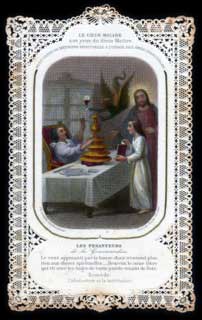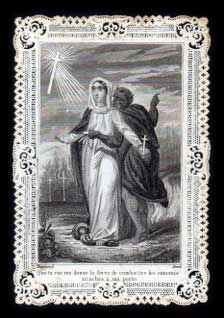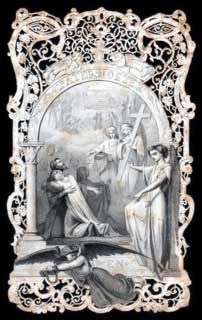 The Catholic Church has always used images to indoctrinate and catechize its fold. In the Middle Ages, images of the devil, juxtaposed to images of the Guardian Angel, were produced and distributed to frighten sinners about the consequences of their transgressions.
The Catholic Church has always used images to indoctrinate and catechize its fold. In the Middle Ages, images of the devil, juxtaposed to images of the Guardian Angel, were produced and distributed to frighten sinners about the consequences of their transgressions.
Since the IX century, the devil was represented as a small, deformed, old, or large variation of the human body. To indoctrinate the faithful about its tricks, the devil was represented as a seductive libidinous woman, or as a saint, in which case the deception was visualized through bestial details–horns, hoofs, bat wings, goat ears. (See for example, on this site, the post “Curiosi Appellativi della Madonna” for the legend of “Madonna con le Corna / Madonna with Horns.”)
Representations of the devil as an animal or monster were remnants of the pagan imaginary (satyrs, chimeras, harpies, gargoyles) as well as of the medieval imaginary (snakes, dragons, monkeys, lions, wolves, cats, gryphons, centaurs, reptiles). Most animal features had to do with the head (goat horns, pointed ears, wolf, dog or lion muzzles, and bird beaks), the extremities (nails, claws, hooves), and the body (usually represented as hairy or scaly and with a pointed tail). A reminder of its divine origin, the devil sports feather wings, similar to those of angels, and in the XII century, bat wings. An important detail of the devil’s image is a wide open mouth with a protruding tongue. The devil’s colors are dark browns, blues, and greens, and in the Middle Ages, reds, linked to blood and the flames of hell.
The Devil on Prayer Cards
Modern prayer cards represent the devil as a small, defeated, and humiliated figure—a snake crushed under the Immaculate Conception’s foot, a dragon slained by Saints, or as in the temptation of Saint Anthony, as a winged human figure. On the other hand, representations of the devil on antique prayer cards recall its role in Christian history and philosophy. Here are two examples:
In the first three centuries of Christendom, the fall of Lucifer, the “Morning Star,” was attributed to envy and lust. In the IV century, its fall was attributed to excessive pride.
In this engraving on background decorated with punch-marks (Dopter, Publisher), Lucifer looks like an angel except for his bull horns, his wings, half-way between those of a crow and a bat, and his angered gaze.
The Angel Seducer
 In the first book of the Bible, Lucifer, the seducer, convinces Eve to eat and make Adam eat the forbidden fruit. He is the seducer of humanity, which he hates, because it is God’s masterpiece, and upon which he takes vengeance by tempting and corrupting it with lust, riches, and power.
In the first book of the Bible, Lucifer, the seducer, convinces Eve to eat and make Adam eat the forbidden fruit. He is the seducer of humanity, which he hates, because it is God’s masterpiece, and upon which he takes vengeance by tempting and corrupting it with lust, riches, and power.
In this engraving (Durand, Publisher), the devil is represented as he tries to seduce a female figure, identified as Mary, Mother of Jesus.
The devil is insidious and relentless: its left hand offers gold jewels, symbols of riches and power, its right hand tries to shift Her gaze from the Cross to the opposite of heaven.
On the background, on the left, the side that leads to God, nature is lush and bathed in the light of the Cross; on the right, the side the devil points to, nature is sterile, scorched by hell’s fire.
– Gianluca Lo Cicero
Italian Collector and Opera Singer
Translated by Mariolina Salvatori
www.gianlucalocicero.com

